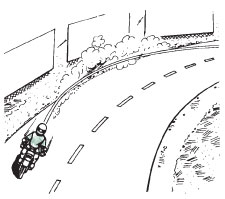The Detection of DWI Motorcyclists
 Drifting During Turn or Curve
Drifting During Turn or Curve
Earlier studies have shown that the most common cause of single-vehicle, fatal motorcycle crashes is the failure to negotiate curves, with the motorcycle continuing in a straight line until it strikes a stationary object. This type of crash is usually caused by alcohol-impaired balance and coordination. In less extreme cases, the motorcycle’s turn radius expands during the maneuver. The motorcycle appears to drift outside of the lane or into another lane, through the curve, or while turning a corner. If you see a motorcycle drifting during a turn or curve, do the rider a favor and pull him or her over – our study showed there is a better than average possibility that the motorcyclist is a DWI offender.
 Trouble with Dismount
Trouble with Dismount
Parking and dismounting a motorcycle can be a useful field sobriety test. The motorcyclist must turn off the engine and locate and deploy the kick-stand. The operator must then balance his or her weight on one foot while swinging the other foot over the seat to dismount. But first, the operator must decide upon a safe place to stop the bike. Problems with any step in this sequence can be evidence of alcohol impairment.
Not every motorcyclist you observe experiencing some difficulty with a dismount is riding under the influence, but study results indicated that more than 50 percent of them were DWI offenders. In other words, having a problem dismounting is a reliable cue to DWI.
 Trouble with Balance at Stop
Trouble with Balance at Stop
One typical practice for motorcycle riders at a stop is for the motorcyclist to place one foot on the ground to keep the bike upright, while leaving the other foot covering the brake pedal. Some riders favor placing both feet on the ground for stability. Riders whose balance has been impaired by alcohol often have difficulty with these tasks. They might be observed as having shifted their weight from side-to-side, that is, from one foot to another, to maintain balance at a stop. From a block away, an officer might notice a single taillight moving from side to side in a gentle rocking motion. If you observe a motorcyclist having trouble with balance at a stop, there is a better than average chance that the operator is a DWI offender.